Strategic Analysis of Aldi: Mission, Vision, and Business Strategy
VerifiedAdded on 2020/06/04
|17
|5875
|66
Report
AI Summary
This report undertakes a comprehensive analysis of Aldi's business strategy, evaluating its mission, vision, goals, and objectives within the competitive UK supermarket landscape. The assignment delves into internal and external factors influencing Aldi's strategic planning, including stakeholder considerations, and the impact of competitors like Tesco and Lidl. It assesses Aldi's current strategic position through SWOT and BCG matrix analyses, identifying strengths in quality and pricing, and weaknesses in market share and brand perception. The report explores the importance of organizational and environmental audits, and proposes a new business strategy for Aldi, including recommendations for resource allocation, the implementation of SMART targets, and the roles and responsibilities for successful strategy execution. The report concludes with an evaluation of Aldi's current strategy, emphasizing its cost leadership approach and potential for future growth.
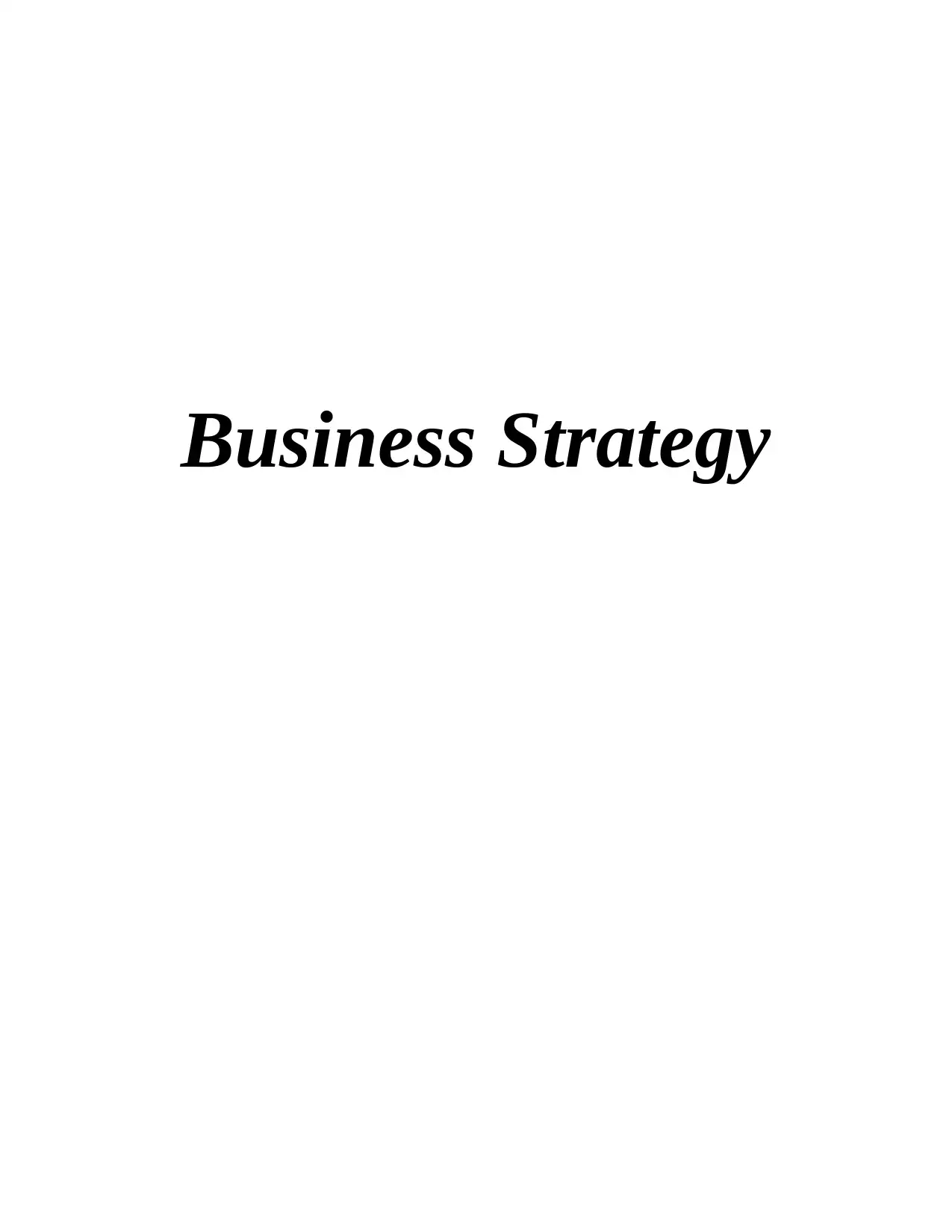
Business Strategy
Paraphrase This Document
Need a fresh take? Get an instant paraphrase of this document with our AI Paraphraser
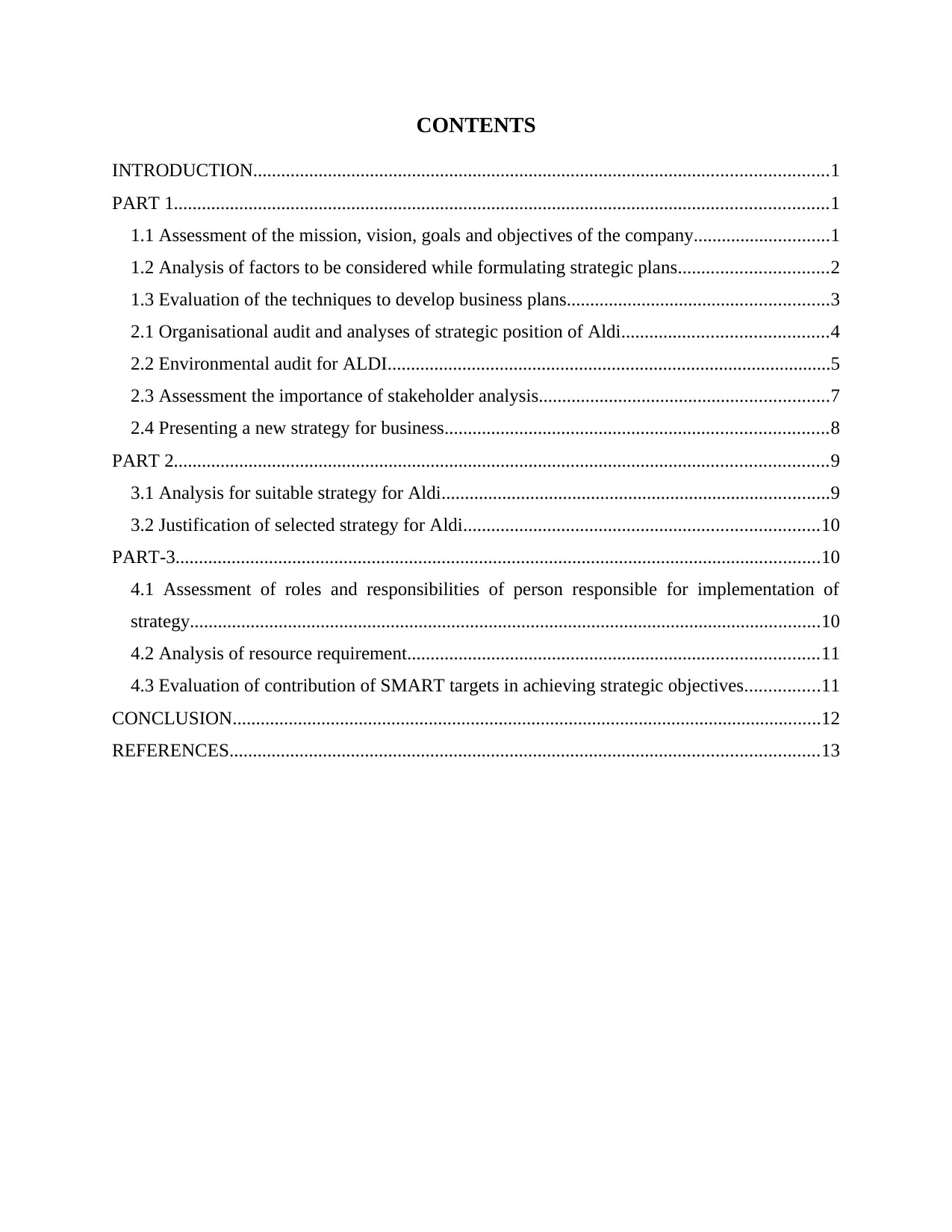
CONTENTS
INTRODUCTION...........................................................................................................................1
PART 1............................................................................................................................................1
1.1 Assessment of the mission, vision, goals and objectives of the company.............................1
1.2 Analysis of factors to be considered while formulating strategic plans................................2
1.3 Evaluation of the techniques to develop business plans........................................................3
2.1 Organisational audit and analyses of strategic position of Aldi............................................4
2.2 Environmental audit for ALDI...............................................................................................5
2.3 Assessment the importance of stakeholder analysis..............................................................7
2.4 Presenting a new strategy for business..................................................................................8
PART 2............................................................................................................................................9
3.1 Analysis for suitable strategy for Aldi...................................................................................9
3.2 Justification of selected strategy for Aldi............................................................................10
PART-3..........................................................................................................................................10
4.1 Assessment of roles and responsibilities of person responsible for implementation of
strategy.......................................................................................................................................10
4.2 Analysis of resource requirement........................................................................................11
4.3 Evaluation of contribution of SMART targets in achieving strategic objectives................11
CONCLUSION..............................................................................................................................12
REFERENCES..............................................................................................................................13
INTRODUCTION...........................................................................................................................1
PART 1............................................................................................................................................1
1.1 Assessment of the mission, vision, goals and objectives of the company.............................1
1.2 Analysis of factors to be considered while formulating strategic plans................................2
1.3 Evaluation of the techniques to develop business plans........................................................3
2.1 Organisational audit and analyses of strategic position of Aldi............................................4
2.2 Environmental audit for ALDI...............................................................................................5
2.3 Assessment the importance of stakeholder analysis..............................................................7
2.4 Presenting a new strategy for business..................................................................................8
PART 2............................................................................................................................................9
3.1 Analysis for suitable strategy for Aldi...................................................................................9
3.2 Justification of selected strategy for Aldi............................................................................10
PART-3..........................................................................................................................................10
4.1 Assessment of roles and responsibilities of person responsible for implementation of
strategy.......................................................................................................................................10
4.2 Analysis of resource requirement........................................................................................11
4.3 Evaluation of contribution of SMART targets in achieving strategic objectives................11
CONCLUSION..............................................................................................................................12
REFERENCES..............................................................................................................................13
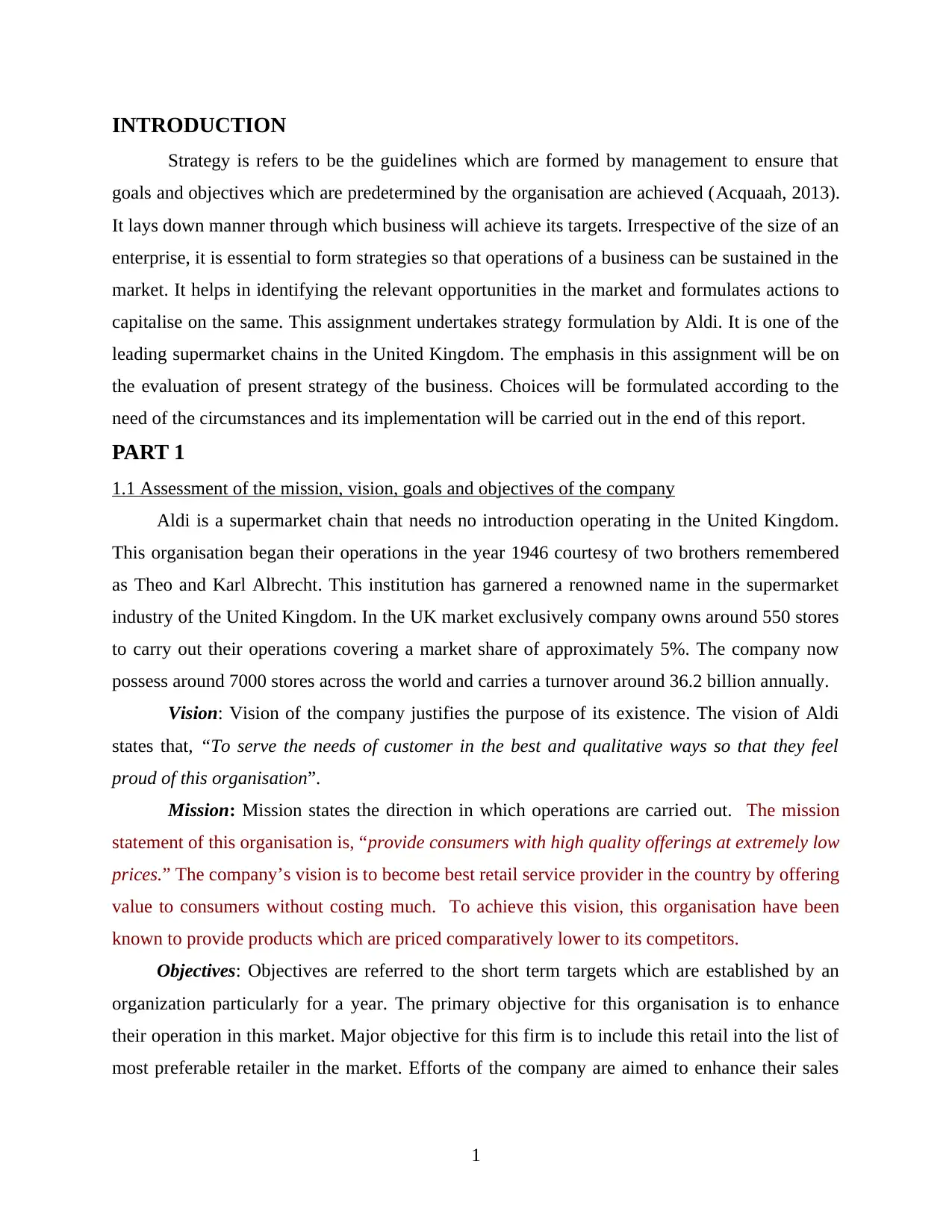
INTRODUCTION
Strategy is refers to be the guidelines which are formed by management to ensure that
goals and objectives which are predetermined by the organisation are achieved (Acquaah, 2013).
It lays down manner through which business will achieve its targets. Irrespective of the size of an
enterprise, it is essential to form strategies so that operations of a business can be sustained in the
market. It helps in identifying the relevant opportunities in the market and formulates actions to
capitalise on the same. This assignment undertakes strategy formulation by Aldi. It is one of the
leading supermarket chains in the United Kingdom. The emphasis in this assignment will be on
the evaluation of present strategy of the business. Choices will be formulated according to the
need of the circumstances and its implementation will be carried out in the end of this report.
PART 1
1.1 Assessment of the mission, vision, goals and objectives of the company
Aldi is a supermarket chain that needs no introduction operating in the United Kingdom.
This organisation began their operations in the year 1946 courtesy of two brothers remembered
as Theo and Karl Albrecht. This institution has garnered a renowned name in the supermarket
industry of the United Kingdom. In the UK market exclusively company owns around 550 stores
to carry out their operations covering a market share of approximately 5%. The company now
possess around 7000 stores across the world and carries a turnover around 36.2 billion annually.
Vision: Vision of the company justifies the purpose of its existence. The vision of Aldi
states that, “To serve the needs of customer in the best and qualitative ways so that they feel
proud of this organisation”.
Mission: Mission states the direction in which operations are carried out. The mission
statement of this organisation is, “provide consumers with high quality offerings at extremely low
prices.” The company’s vision is to become best retail service provider in the country by offering
value to consumers without costing much. To achieve this vision, this organisation have been
known to provide products which are priced comparatively lower to its competitors.
Objectives: Objectives are referred to the short term targets which are established by an
organization particularly for a year. The primary objective for this organisation is to enhance
their operation in this market. Major objective for this firm is to include this retail into the list of
most preferable retailer in the market. Efforts of the company are aimed to enhance their sales
1
Strategy is refers to be the guidelines which are formed by management to ensure that
goals and objectives which are predetermined by the organisation are achieved (Acquaah, 2013).
It lays down manner through which business will achieve its targets. Irrespective of the size of an
enterprise, it is essential to form strategies so that operations of a business can be sustained in the
market. It helps in identifying the relevant opportunities in the market and formulates actions to
capitalise on the same. This assignment undertakes strategy formulation by Aldi. It is one of the
leading supermarket chains in the United Kingdom. The emphasis in this assignment will be on
the evaluation of present strategy of the business. Choices will be formulated according to the
need of the circumstances and its implementation will be carried out in the end of this report.
PART 1
1.1 Assessment of the mission, vision, goals and objectives of the company
Aldi is a supermarket chain that needs no introduction operating in the United Kingdom.
This organisation began their operations in the year 1946 courtesy of two brothers remembered
as Theo and Karl Albrecht. This institution has garnered a renowned name in the supermarket
industry of the United Kingdom. In the UK market exclusively company owns around 550 stores
to carry out their operations covering a market share of approximately 5%. The company now
possess around 7000 stores across the world and carries a turnover around 36.2 billion annually.
Vision: Vision of the company justifies the purpose of its existence. The vision of Aldi
states that, “To serve the needs of customer in the best and qualitative ways so that they feel
proud of this organisation”.
Mission: Mission states the direction in which operations are carried out. The mission
statement of this organisation is, “provide consumers with high quality offerings at extremely low
prices.” The company’s vision is to become best retail service provider in the country by offering
value to consumers without costing much. To achieve this vision, this organisation have been
known to provide products which are priced comparatively lower to its competitors.
Objectives: Objectives are referred to the short term targets which are established by an
organization particularly for a year. The primary objective for this organisation is to enhance
their operation in this market. Major objective for this firm is to include this retail into the list of
most preferable retailer in the market. Efforts of the company are aimed to enhance their sales
1
⊘ This is a preview!⊘
Do you want full access?
Subscribe today to unlock all pages.

Trusted by 1+ million students worldwide
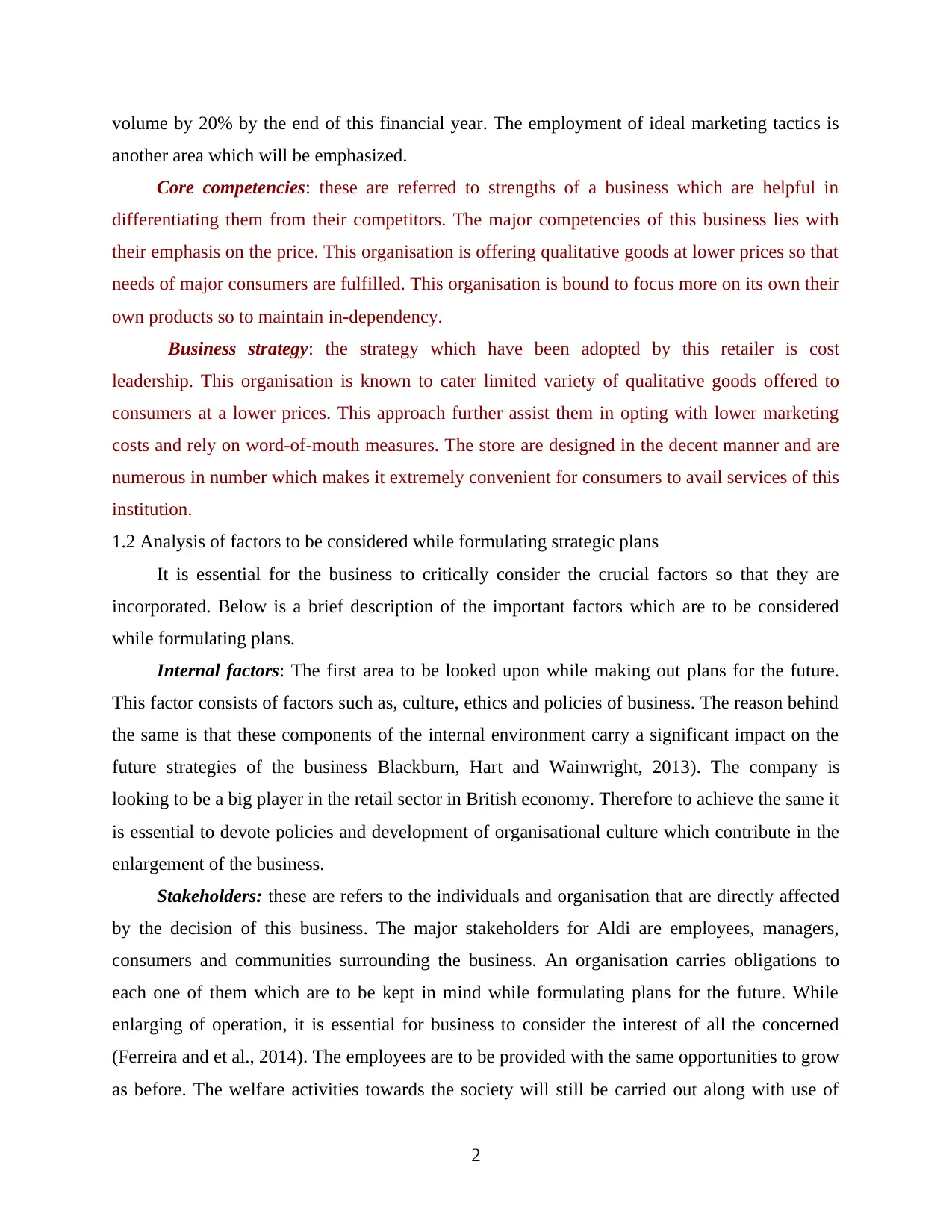
volume by 20% by the end of this financial year. The employment of ideal marketing tactics is
another area which will be emphasized.
Core competencies: these are referred to strengths of a business which are helpful in
differentiating them from their competitors. The major competencies of this business lies with
their emphasis on the price. This organisation is offering qualitative goods at lower prices so that
needs of major consumers are fulfilled. This organisation is bound to focus more on its own their
own products so to maintain in-dependency.
Business strategy: the strategy which have been adopted by this retailer is cost
leadership. This organisation is known to cater limited variety of qualitative goods offered to
consumers at a lower prices. This approach further assist them in opting with lower marketing
costs and rely on word-of-mouth measures. The store are designed in the decent manner and are
numerous in number which makes it extremely convenient for consumers to avail services of this
institution.
1.2 Analysis of factors to be considered while formulating strategic plans
It is essential for the business to critically consider the crucial factors so that they are
incorporated. Below is a brief description of the important factors which are to be considered
while formulating plans.
Internal factors: The first area to be looked upon while making out plans for the future.
This factor consists of factors such as, culture, ethics and policies of business. The reason behind
the same is that these components of the internal environment carry a significant impact on the
future strategies of the business Blackburn, Hart and Wainwright, 2013). The company is
looking to be a big player in the retail sector in British economy. Therefore to achieve the same it
is essential to devote policies and development of organisational culture which contribute in the
enlargement of the business.
Stakeholders: these are refers to the individuals and organisation that are directly affected
by the decision of this business. The major stakeholders for Aldi are employees, managers,
consumers and communities surrounding the business. An organisation carries obligations to
each one of them which are to be kept in mind while formulating plans for the future. While
enlarging of operation, it is essential for business to consider the interest of all the concerned
(Ferreira and et al., 2014). The employees are to be provided with the same opportunities to grow
as before. The welfare activities towards the society will still be carried out along with use of
2
another area which will be emphasized.
Core competencies: these are referred to strengths of a business which are helpful in
differentiating them from their competitors. The major competencies of this business lies with
their emphasis on the price. This organisation is offering qualitative goods at lower prices so that
needs of major consumers are fulfilled. This organisation is bound to focus more on its own their
own products so to maintain in-dependency.
Business strategy: the strategy which have been adopted by this retailer is cost
leadership. This organisation is known to cater limited variety of qualitative goods offered to
consumers at a lower prices. This approach further assist them in opting with lower marketing
costs and rely on word-of-mouth measures. The store are designed in the decent manner and are
numerous in number which makes it extremely convenient for consumers to avail services of this
institution.
1.2 Analysis of factors to be considered while formulating strategic plans
It is essential for the business to critically consider the crucial factors so that they are
incorporated. Below is a brief description of the important factors which are to be considered
while formulating plans.
Internal factors: The first area to be looked upon while making out plans for the future.
This factor consists of factors such as, culture, ethics and policies of business. The reason behind
the same is that these components of the internal environment carry a significant impact on the
future strategies of the business Blackburn, Hart and Wainwright, 2013). The company is
looking to be a big player in the retail sector in British economy. Therefore to achieve the same it
is essential to devote policies and development of organisational culture which contribute in the
enlargement of the business.
Stakeholders: these are refers to the individuals and organisation that are directly affected
by the decision of this business. The major stakeholders for Aldi are employees, managers,
consumers and communities surrounding the business. An organisation carries obligations to
each one of them which are to be kept in mind while formulating plans for the future. While
enlarging of operation, it is essential for business to consider the interest of all the concerned
(Ferreira and et al., 2014). The employees are to be provided with the same opportunities to grow
as before. The welfare activities towards the society will still be carried out along with use of
2
Paraphrase This Document
Need a fresh take? Get an instant paraphrase of this document with our AI Paraphraser
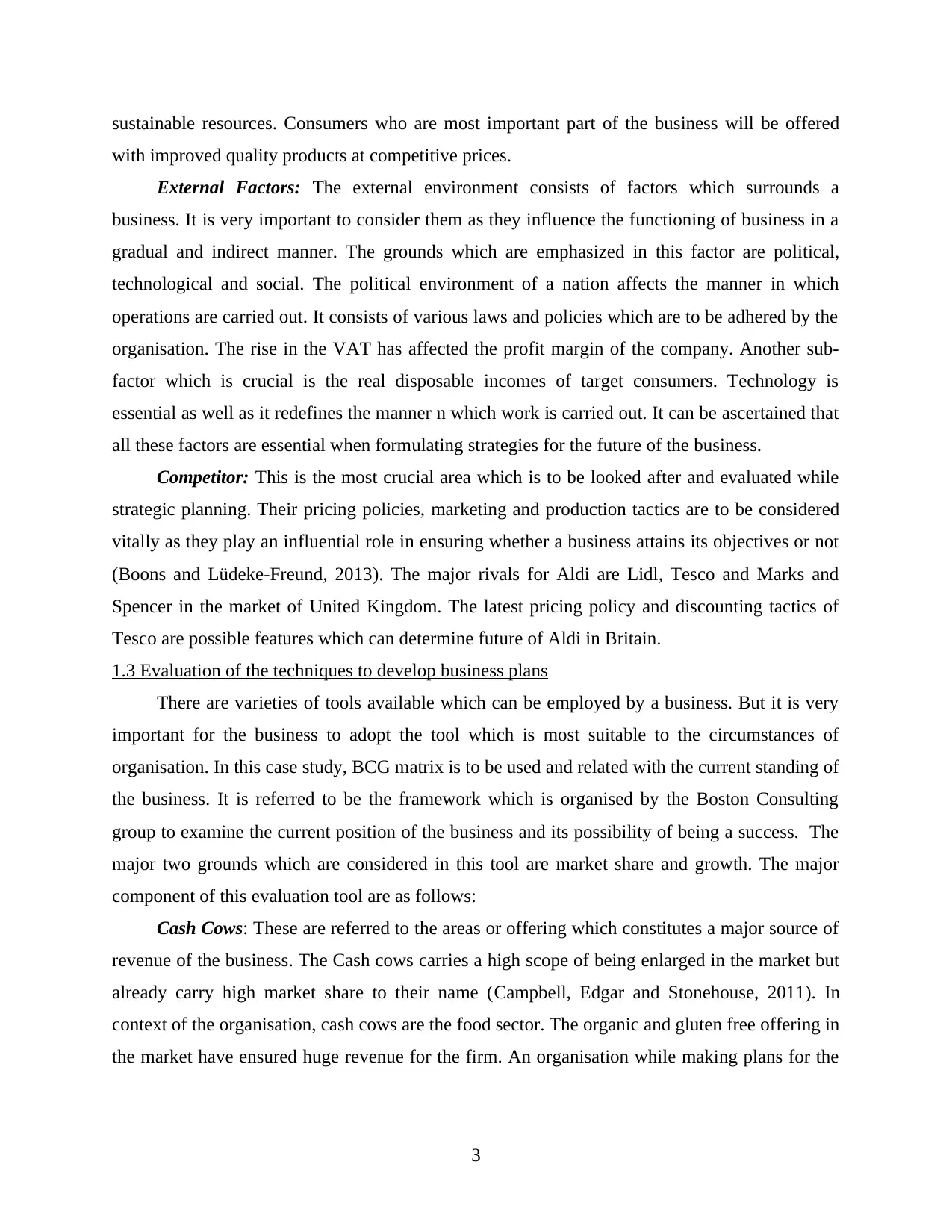
sustainable resources. Consumers who are most important part of the business will be offered
with improved quality products at competitive prices.
External Factors: The external environment consists of factors which surrounds a
business. It is very important to consider them as they influence the functioning of business in a
gradual and indirect manner. The grounds which are emphasized in this factor are political,
technological and social. The political environment of a nation affects the manner in which
operations are carried out. It consists of various laws and policies which are to be adhered by the
organisation. The rise in the VAT has affected the profit margin of the company. Another sub-
factor which is crucial is the real disposable incomes of target consumers. Technology is
essential as well as it redefines the manner n which work is carried out. It can be ascertained that
all these factors are essential when formulating strategies for the future of the business.
Competitor: This is the most crucial area which is to be looked after and evaluated while
strategic planning. Their pricing policies, marketing and production tactics are to be considered
vitally as they play an influential role in ensuring whether a business attains its objectives or not
(Boons and Lüdeke-Freund, 2013). The major rivals for Aldi are Lidl, Tesco and Marks and
Spencer in the market of United Kingdom. The latest pricing policy and discounting tactics of
Tesco are possible features which can determine future of Aldi in Britain.
1.3 Evaluation of the techniques to develop business plans
There are varieties of tools available which can be employed by a business. But it is very
important for the business to adopt the tool which is most suitable to the circumstances of
organisation. In this case study, BCG matrix is to be used and related with the current standing of
the business. It is referred to be the framework which is organised by the Boston Consulting
group to examine the current position of the business and its possibility of being a success. The
major two grounds which are considered in this tool are market share and growth. The major
component of this evaluation tool are as follows:
Cash Cows: These are referred to the areas or offering which constitutes a major source of
revenue of the business. The Cash cows carries a high scope of being enlarged in the market but
already carry high market share to their name (Campbell, Edgar and Stonehouse, 2011). In
context of the organisation, cash cows are the food sector. The organic and gluten free offering in
the market have ensured huge revenue for the firm. An organisation while making plans for the
3
with improved quality products at competitive prices.
External Factors: The external environment consists of factors which surrounds a
business. It is very important to consider them as they influence the functioning of business in a
gradual and indirect manner. The grounds which are emphasized in this factor are political,
technological and social. The political environment of a nation affects the manner in which
operations are carried out. It consists of various laws and policies which are to be adhered by the
organisation. The rise in the VAT has affected the profit margin of the company. Another sub-
factor which is crucial is the real disposable incomes of target consumers. Technology is
essential as well as it redefines the manner n which work is carried out. It can be ascertained that
all these factors are essential when formulating strategies for the future of the business.
Competitor: This is the most crucial area which is to be looked after and evaluated while
strategic planning. Their pricing policies, marketing and production tactics are to be considered
vitally as they play an influential role in ensuring whether a business attains its objectives or not
(Boons and Lüdeke-Freund, 2013). The major rivals for Aldi are Lidl, Tesco and Marks and
Spencer in the market of United Kingdom. The latest pricing policy and discounting tactics of
Tesco are possible features which can determine future of Aldi in Britain.
1.3 Evaluation of the techniques to develop business plans
There are varieties of tools available which can be employed by a business. But it is very
important for the business to adopt the tool which is most suitable to the circumstances of
organisation. In this case study, BCG matrix is to be used and related with the current standing of
the business. It is referred to be the framework which is organised by the Boston Consulting
group to examine the current position of the business and its possibility of being a success. The
major two grounds which are considered in this tool are market share and growth. The major
component of this evaluation tool are as follows:
Cash Cows: These are referred to the areas or offering which constitutes a major source of
revenue of the business. The Cash cows carries a high scope of being enlarged in the market but
already carry high market share to their name (Campbell, Edgar and Stonehouse, 2011). In
context of the organisation, cash cows are the food sector. The organic and gluten free offering in
the market have ensured huge revenue for the firm. An organisation while making plans for the
3
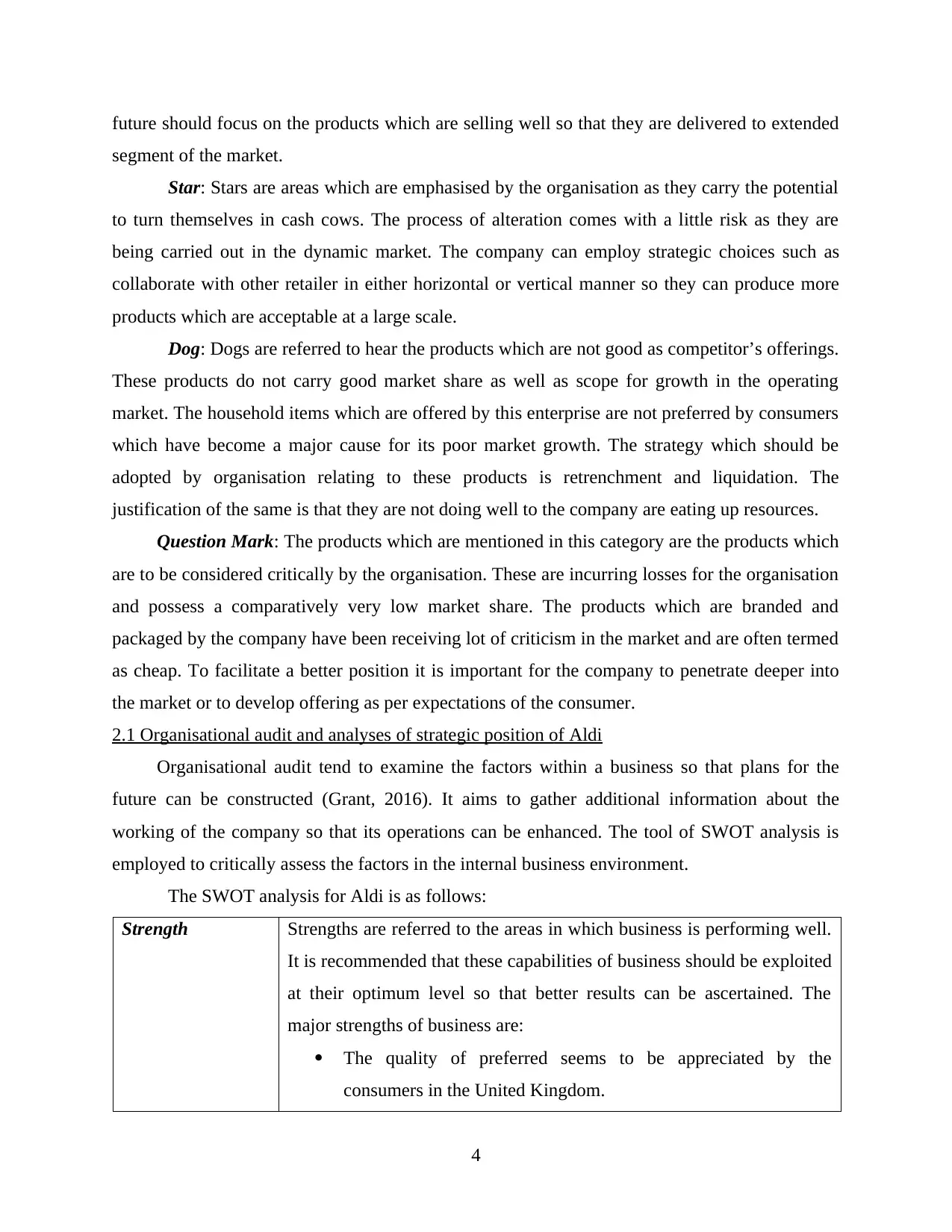
future should focus on the products which are selling well so that they are delivered to extended
segment of the market.
Star: Stars are areas which are emphasised by the organisation as they carry the potential
to turn themselves in cash cows. The process of alteration comes with a little risk as they are
being carried out in the dynamic market. The company can employ strategic choices such as
collaborate with other retailer in either horizontal or vertical manner so they can produce more
products which are acceptable at a large scale.
Dog: Dogs are referred to hear the products which are not good as competitor’s offerings.
These products do not carry good market share as well as scope for growth in the operating
market. The household items which are offered by this enterprise are not preferred by consumers
which have become a major cause for its poor market growth. The strategy which should be
adopted by organisation relating to these products is retrenchment and liquidation. The
justification of the same is that they are not doing well to the company are eating up resources.
Question Mark: The products which are mentioned in this category are the products which
are to be considered critically by the organisation. These are incurring losses for the organisation
and possess a comparatively very low market share. The products which are branded and
packaged by the company have been receiving lot of criticism in the market and are often termed
as cheap. To facilitate a better position it is important for the company to penetrate deeper into
the market or to develop offering as per expectations of the consumer.
2.1 Organisational audit and analyses of strategic position of Aldi
Organisational audit tend to examine the factors within a business so that plans for the
future can be constructed (Grant, 2016). It aims to gather additional information about the
working of the company so that its operations can be enhanced. The tool of SWOT analysis is
employed to critically assess the factors in the internal business environment.
The SWOT analysis for Aldi is as follows:
Strength Strengths are referred to the areas in which business is performing well.
It is recommended that these capabilities of business should be exploited
at their optimum level so that better results can be ascertained. The
major strengths of business are:
The quality of preferred seems to be appreciated by the
consumers in the United Kingdom.
4
segment of the market.
Star: Stars are areas which are emphasised by the organisation as they carry the potential
to turn themselves in cash cows. The process of alteration comes with a little risk as they are
being carried out in the dynamic market. The company can employ strategic choices such as
collaborate with other retailer in either horizontal or vertical manner so they can produce more
products which are acceptable at a large scale.
Dog: Dogs are referred to hear the products which are not good as competitor’s offerings.
These products do not carry good market share as well as scope for growth in the operating
market. The household items which are offered by this enterprise are not preferred by consumers
which have become a major cause for its poor market growth. The strategy which should be
adopted by organisation relating to these products is retrenchment and liquidation. The
justification of the same is that they are not doing well to the company are eating up resources.
Question Mark: The products which are mentioned in this category are the products which
are to be considered critically by the organisation. These are incurring losses for the organisation
and possess a comparatively very low market share. The products which are branded and
packaged by the company have been receiving lot of criticism in the market and are often termed
as cheap. To facilitate a better position it is important for the company to penetrate deeper into
the market or to develop offering as per expectations of the consumer.
2.1 Organisational audit and analyses of strategic position of Aldi
Organisational audit tend to examine the factors within a business so that plans for the
future can be constructed (Grant, 2016). It aims to gather additional information about the
working of the company so that its operations can be enhanced. The tool of SWOT analysis is
employed to critically assess the factors in the internal business environment.
The SWOT analysis for Aldi is as follows:
Strength Strengths are referred to the areas in which business is performing well.
It is recommended that these capabilities of business should be exploited
at their optimum level so that better results can be ascertained. The
major strengths of business are:
The quality of preferred seems to be appreciated by the
consumers in the United Kingdom.
4
⊘ This is a preview!⊘
Do you want full access?
Subscribe today to unlock all pages.

Trusted by 1+ million students worldwide
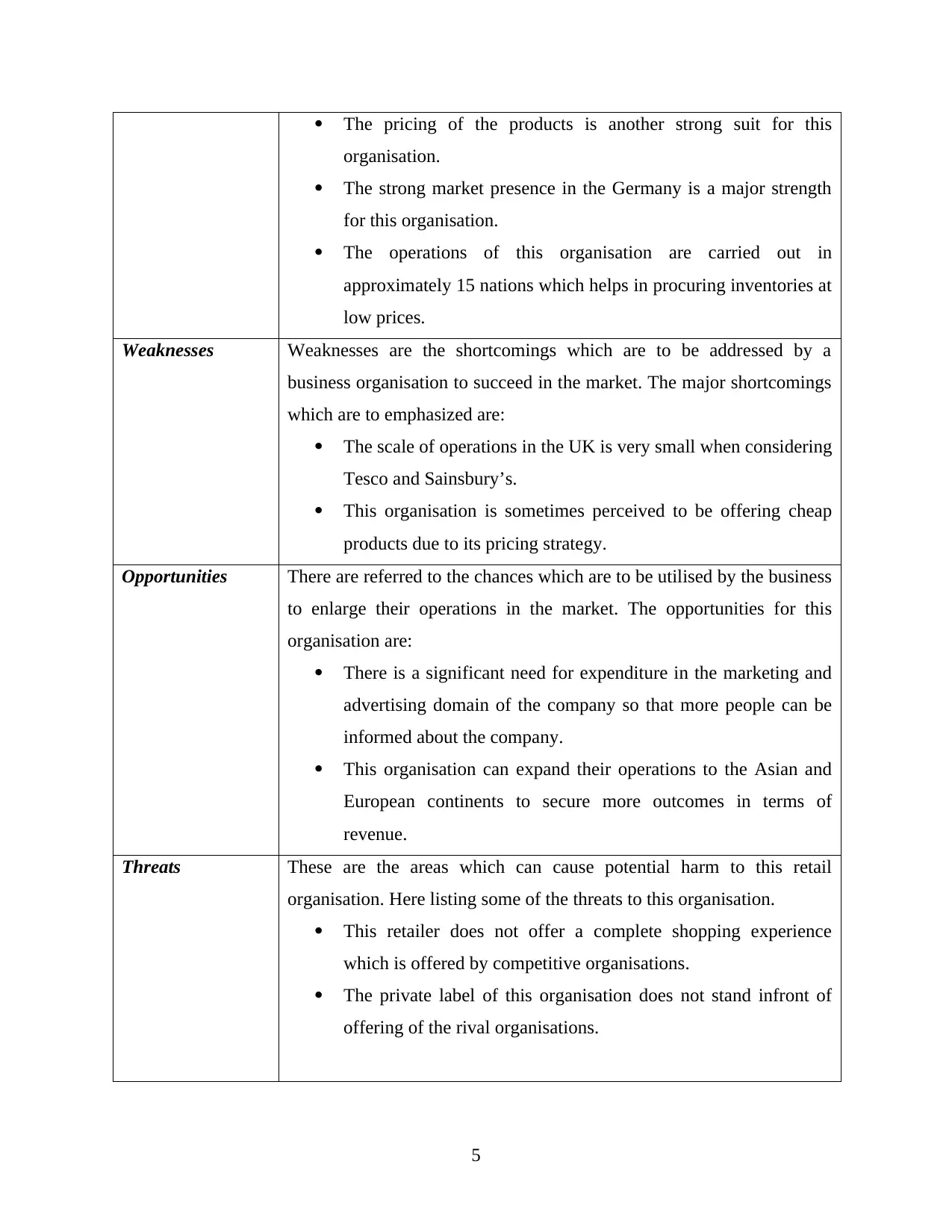
The pricing of the products is another strong suit for this
organisation.
The strong market presence in the Germany is a major strength
for this organisation.
The operations of this organisation are carried out in
approximately 15 nations which helps in procuring inventories at
low prices.
Weaknesses Weaknesses are the shortcomings which are to be addressed by a
business organisation to succeed in the market. The major shortcomings
which are to emphasized are:
The scale of operations in the UK is very small when considering
Tesco and Sainsbury’s.
This organisation is sometimes perceived to be offering cheap
products due to its pricing strategy.
Opportunities There are referred to the chances which are to be utilised by the business
to enlarge their operations in the market. The opportunities for this
organisation are:
There is a significant need for expenditure in the marketing and
advertising domain of the company so that more people can be
informed about the company.
This organisation can expand their operations to the Asian and
European continents to secure more outcomes in terms of
revenue.
Threats These are the areas which can cause potential harm to this retail
organisation. Here listing some of the threats to this organisation.
This retailer does not offer a complete shopping experience
which is offered by competitive organisations.
The private label of this organisation does not stand infront of
offering of the rival organisations.
5
organisation.
The strong market presence in the Germany is a major strength
for this organisation.
The operations of this organisation are carried out in
approximately 15 nations which helps in procuring inventories at
low prices.
Weaknesses Weaknesses are the shortcomings which are to be addressed by a
business organisation to succeed in the market. The major shortcomings
which are to emphasized are:
The scale of operations in the UK is very small when considering
Tesco and Sainsbury’s.
This organisation is sometimes perceived to be offering cheap
products due to its pricing strategy.
Opportunities There are referred to the chances which are to be utilised by the business
to enlarge their operations in the market. The opportunities for this
organisation are:
There is a significant need for expenditure in the marketing and
advertising domain of the company so that more people can be
informed about the company.
This organisation can expand their operations to the Asian and
European continents to secure more outcomes in terms of
revenue.
Threats These are the areas which can cause potential harm to this retail
organisation. Here listing some of the threats to this organisation.
This retailer does not offer a complete shopping experience
which is offered by competitive organisations.
The private label of this organisation does not stand infront of
offering of the rival organisations.
5
Paraphrase This Document
Need a fresh take? Get an instant paraphrase of this document with our AI Paraphraser
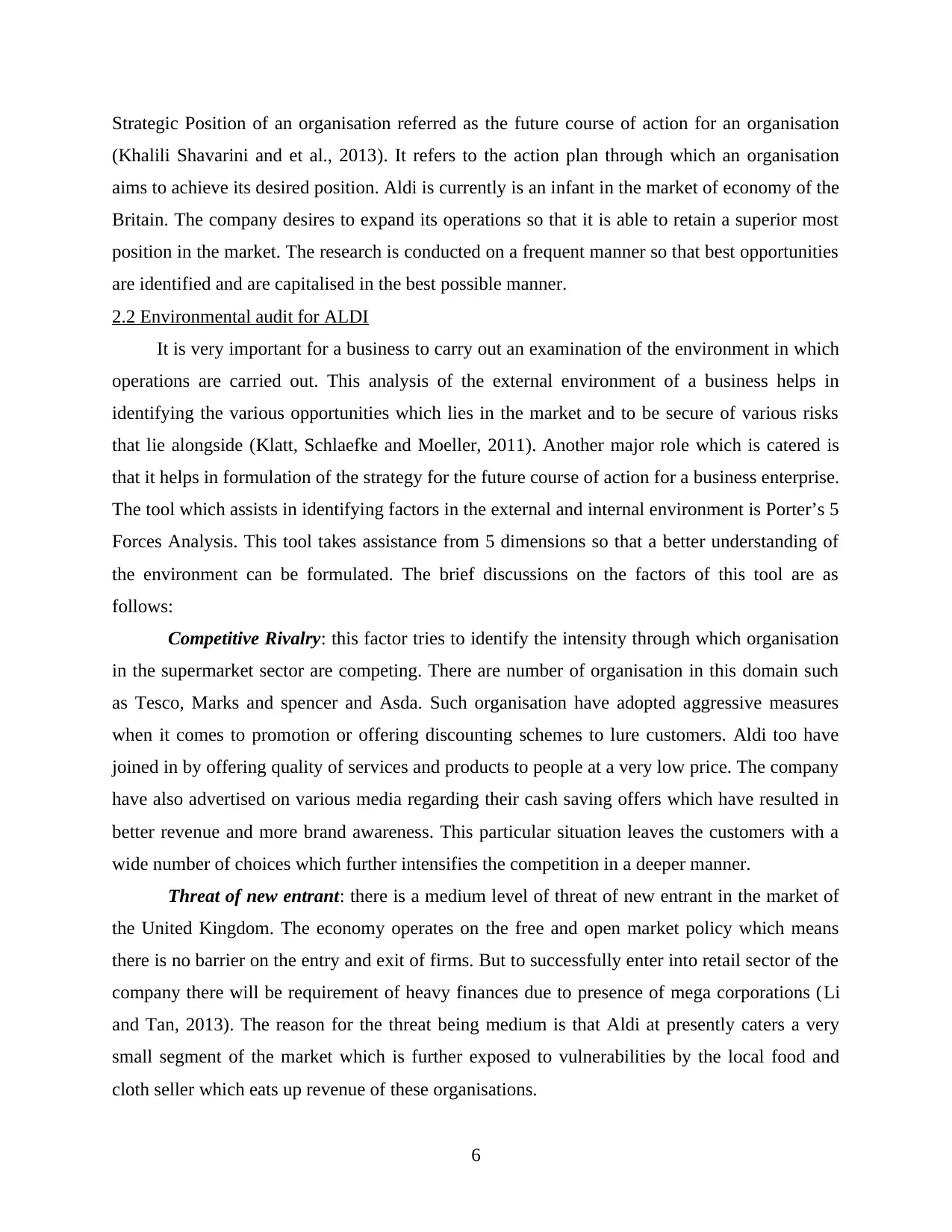
Strategic Position of an organisation referred as the future course of action for an organisation
(Khalili Shavarini and et al., 2013). It refers to the action plan through which an organisation
aims to achieve its desired position. Aldi is currently is an infant in the market of economy of the
Britain. The company desires to expand its operations so that it is able to retain a superior most
position in the market. The research is conducted on a frequent manner so that best opportunities
are identified and are capitalised in the best possible manner.
2.2 Environmental audit for ALDI
It is very important for a business to carry out an examination of the environment in which
operations are carried out. This analysis of the external environment of a business helps in
identifying the various opportunities which lies in the market and to be secure of various risks
that lie alongside (Klatt, Schlaefke and Moeller, 2011). Another major role which is catered is
that it helps in formulation of the strategy for the future course of action for a business enterprise.
The tool which assists in identifying factors in the external and internal environment is Porter’s 5
Forces Analysis. This tool takes assistance from 5 dimensions so that a better understanding of
the environment can be formulated. The brief discussions on the factors of this tool are as
follows:
Competitive Rivalry: this factor tries to identify the intensity through which organisation
in the supermarket sector are competing. There are number of organisation in this domain such
as Tesco, Marks and spencer and Asda. Such organisation have adopted aggressive measures
when it comes to promotion or offering discounting schemes to lure customers. Aldi too have
joined in by offering quality of services and products to people at a very low price. The company
have also advertised on various media regarding their cash saving offers which have resulted in
better revenue and more brand awareness. This particular situation leaves the customers with a
wide number of choices which further intensifies the competition in a deeper manner.
Threat of new entrant: there is a medium level of threat of new entrant in the market of
the United Kingdom. The economy operates on the free and open market policy which means
there is no barrier on the entry and exit of firms. But to successfully enter into retail sector of the
company there will be requirement of heavy finances due to presence of mega corporations (Li
and Tan, 2013). The reason for the threat being medium is that Aldi at presently caters a very
small segment of the market which is further exposed to vulnerabilities by the local food and
cloth seller which eats up revenue of these organisations.
6
(Khalili Shavarini and et al., 2013). It refers to the action plan through which an organisation
aims to achieve its desired position. Aldi is currently is an infant in the market of economy of the
Britain. The company desires to expand its operations so that it is able to retain a superior most
position in the market. The research is conducted on a frequent manner so that best opportunities
are identified and are capitalised in the best possible manner.
2.2 Environmental audit for ALDI
It is very important for a business to carry out an examination of the environment in which
operations are carried out. This analysis of the external environment of a business helps in
identifying the various opportunities which lies in the market and to be secure of various risks
that lie alongside (Klatt, Schlaefke and Moeller, 2011). Another major role which is catered is
that it helps in formulation of the strategy for the future course of action for a business enterprise.
The tool which assists in identifying factors in the external and internal environment is Porter’s 5
Forces Analysis. This tool takes assistance from 5 dimensions so that a better understanding of
the environment can be formulated. The brief discussions on the factors of this tool are as
follows:
Competitive Rivalry: this factor tries to identify the intensity through which organisation
in the supermarket sector are competing. There are number of organisation in this domain such
as Tesco, Marks and spencer and Asda. Such organisation have adopted aggressive measures
when it comes to promotion or offering discounting schemes to lure customers. Aldi too have
joined in by offering quality of services and products to people at a very low price. The company
have also advertised on various media regarding their cash saving offers which have resulted in
better revenue and more brand awareness. This particular situation leaves the customers with a
wide number of choices which further intensifies the competition in a deeper manner.
Threat of new entrant: there is a medium level of threat of new entrant in the market of
the United Kingdom. The economy operates on the free and open market policy which means
there is no barrier on the entry and exit of firms. But to successfully enter into retail sector of the
company there will be requirement of heavy finances due to presence of mega corporations (Li
and Tan, 2013). The reason for the threat being medium is that Aldi at presently caters a very
small segment of the market which is further exposed to vulnerabilities by the local food and
cloth seller which eats up revenue of these organisations.
6
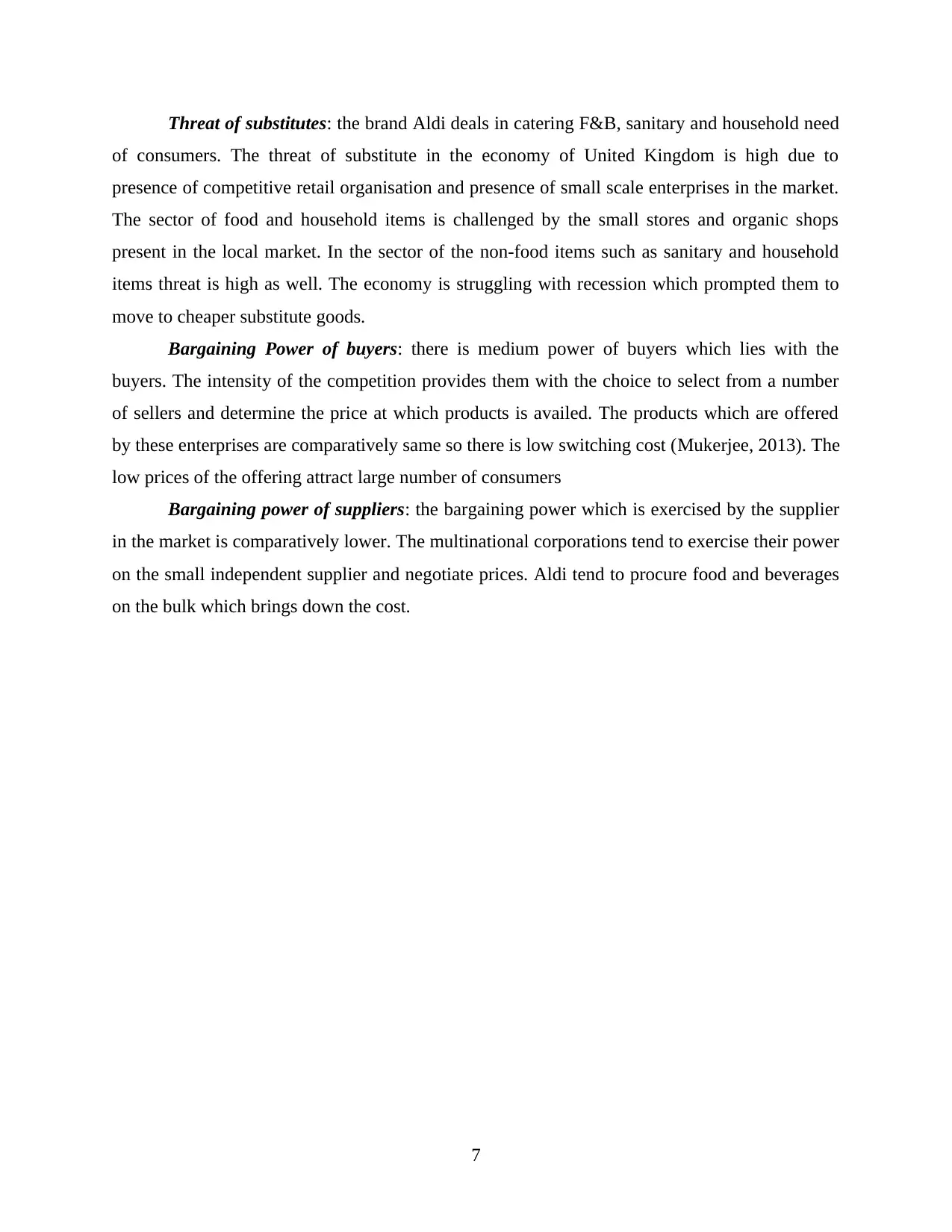
Threat of substitutes: the brand Aldi deals in catering F&B, sanitary and household need
of consumers. The threat of substitute in the economy of United Kingdom is high due to
presence of competitive retail organisation and presence of small scale enterprises in the market.
The sector of food and household items is challenged by the small stores and organic shops
present in the local market. In the sector of the non-food items such as sanitary and household
items threat is high as well. The economy is struggling with recession which prompted them to
move to cheaper substitute goods.
Bargaining Power of buyers: there is medium power of buyers which lies with the
buyers. The intensity of the competition provides them with the choice to select from a number
of sellers and determine the price at which products is availed. The products which are offered
by these enterprises are comparatively same so there is low switching cost (Mukerjee, 2013). The
low prices of the offering attract large number of consumers
Bargaining power of suppliers: the bargaining power which is exercised by the supplier
in the market is comparatively lower. The multinational corporations tend to exercise their power
on the small independent supplier and negotiate prices. Aldi tend to procure food and beverages
on the bulk which brings down the cost.
7
of consumers. The threat of substitute in the economy of United Kingdom is high due to
presence of competitive retail organisation and presence of small scale enterprises in the market.
The sector of food and household items is challenged by the small stores and organic shops
present in the local market. In the sector of the non-food items such as sanitary and household
items threat is high as well. The economy is struggling with recession which prompted them to
move to cheaper substitute goods.
Bargaining Power of buyers: there is medium power of buyers which lies with the
buyers. The intensity of the competition provides them with the choice to select from a number
of sellers and determine the price at which products is availed. The products which are offered
by these enterprises are comparatively same so there is low switching cost (Mukerjee, 2013). The
low prices of the offering attract large number of consumers
Bargaining power of suppliers: the bargaining power which is exercised by the supplier
in the market is comparatively lower. The multinational corporations tend to exercise their power
on the small independent supplier and negotiate prices. Aldi tend to procure food and beverages
on the bulk which brings down the cost.
7
⊘ This is a preview!⊘
Do you want full access?
Subscribe today to unlock all pages.

Trusted by 1+ million students worldwide
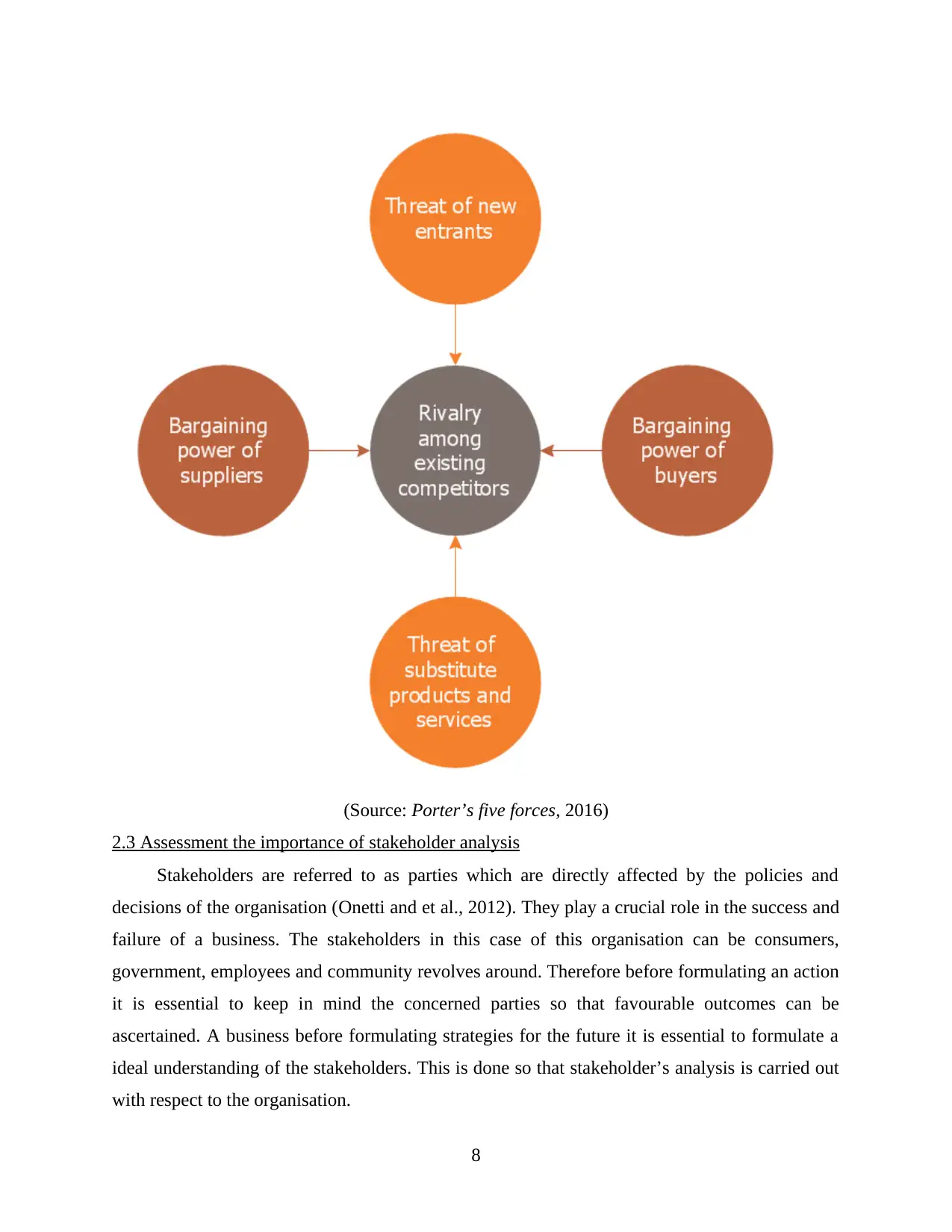
(Source: Porter’s five forces, 2016)
2.3 Assessment the importance of stakeholder analysis
Stakeholders are referred to as parties which are directly affected by the policies and
decisions of the organisation (Onetti and et al., 2012). They play a crucial role in the success and
failure of a business. The stakeholders in this case of this organisation can be consumers,
government, employees and community revolves around. Therefore before formulating an action
it is essential to keep in mind the concerned parties so that favourable outcomes can be
ascertained. A business before formulating strategies for the future it is essential to formulate a
ideal understanding of the stakeholders. This is done so that stakeholder’s analysis is carried out
with respect to the organisation.
8
2.3 Assessment the importance of stakeholder analysis
Stakeholders are referred to as parties which are directly affected by the policies and
decisions of the organisation (Onetti and et al., 2012). They play a crucial role in the success and
failure of a business. The stakeholders in this case of this organisation can be consumers,
government, employees and community revolves around. Therefore before formulating an action
it is essential to keep in mind the concerned parties so that favourable outcomes can be
ascertained. A business before formulating strategies for the future it is essential to formulate a
ideal understanding of the stakeholders. This is done so that stakeholder’s analysis is carried out
with respect to the organisation.
8
Paraphrase This Document
Need a fresh take? Get an instant paraphrase of this document with our AI Paraphraser
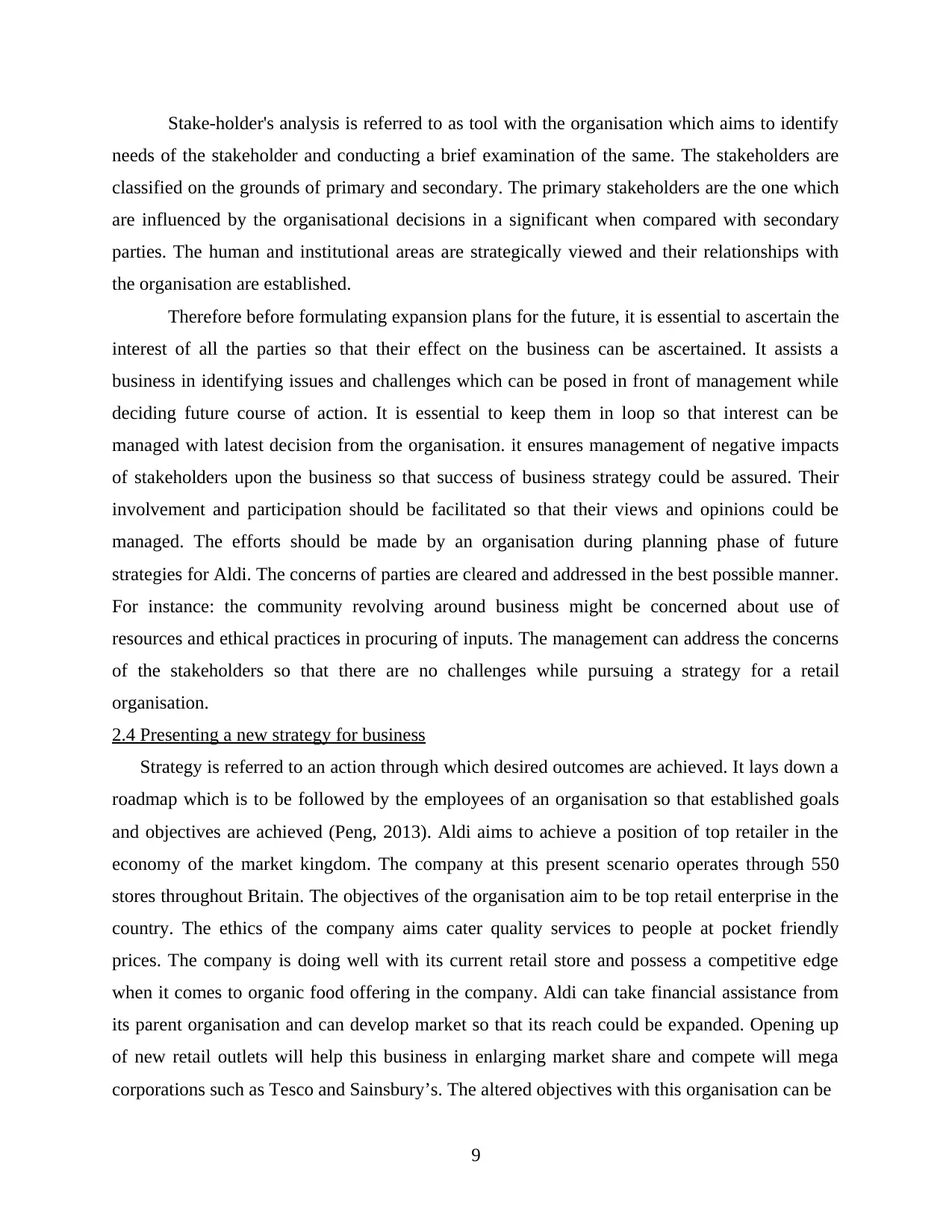
Stake-holder's analysis is referred to as tool with the organisation which aims to identify
needs of the stakeholder and conducting a brief examination of the same. The stakeholders are
classified on the grounds of primary and secondary. The primary stakeholders are the one which
are influenced by the organisational decisions in a significant when compared with secondary
parties. The human and institutional areas are strategically viewed and their relationships with
the organisation are established.
Therefore before formulating expansion plans for the future, it is essential to ascertain the
interest of all the parties so that their effect on the business can be ascertained. It assists a
business in identifying issues and challenges which can be posed in front of management while
deciding future course of action. It is essential to keep them in loop so that interest can be
managed with latest decision from the organisation. it ensures management of negative impacts
of stakeholders upon the business so that success of business strategy could be assured. Their
involvement and participation should be facilitated so that their views and opinions could be
managed. The efforts should be made by an organisation during planning phase of future
strategies for Aldi. The concerns of parties are cleared and addressed in the best possible manner.
For instance: the community revolving around business might be concerned about use of
resources and ethical practices in procuring of inputs. The management can address the concerns
of the stakeholders so that there are no challenges while pursuing a strategy for a retail
organisation.
2.4 Presenting a new strategy for business
Strategy is referred to an action through which desired outcomes are achieved. It lays down a
roadmap which is to be followed by the employees of an organisation so that established goals
and objectives are achieved (Peng, 2013). Aldi aims to achieve a position of top retailer in the
economy of the market kingdom. The company at this present scenario operates through 550
stores throughout Britain. The objectives of the organisation aim to be top retail enterprise in the
country. The ethics of the company aims cater quality services to people at pocket friendly
prices. The company is doing well with its current retail store and possess a competitive edge
when it comes to organic food offering in the company. Aldi can take financial assistance from
its parent organisation and can develop market so that its reach could be expanded. Opening up
of new retail outlets will help this business in enlarging market share and compete will mega
corporations such as Tesco and Sainsbury’s. The altered objectives with this organisation can be
9
needs of the stakeholder and conducting a brief examination of the same. The stakeholders are
classified on the grounds of primary and secondary. The primary stakeholders are the one which
are influenced by the organisational decisions in a significant when compared with secondary
parties. The human and institutional areas are strategically viewed and their relationships with
the organisation are established.
Therefore before formulating expansion plans for the future, it is essential to ascertain the
interest of all the parties so that their effect on the business can be ascertained. It assists a
business in identifying issues and challenges which can be posed in front of management while
deciding future course of action. It is essential to keep them in loop so that interest can be
managed with latest decision from the organisation. it ensures management of negative impacts
of stakeholders upon the business so that success of business strategy could be assured. Their
involvement and participation should be facilitated so that their views and opinions could be
managed. The efforts should be made by an organisation during planning phase of future
strategies for Aldi. The concerns of parties are cleared and addressed in the best possible manner.
For instance: the community revolving around business might be concerned about use of
resources and ethical practices in procuring of inputs. The management can address the concerns
of the stakeholders so that there are no challenges while pursuing a strategy for a retail
organisation.
2.4 Presenting a new strategy for business
Strategy is referred to an action through which desired outcomes are achieved. It lays down a
roadmap which is to be followed by the employees of an organisation so that established goals
and objectives are achieved (Peng, 2013). Aldi aims to achieve a position of top retailer in the
economy of the market kingdom. The company at this present scenario operates through 550
stores throughout Britain. The objectives of the organisation aim to be top retail enterprise in the
country. The ethics of the company aims cater quality services to people at pocket friendly
prices. The company is doing well with its current retail store and possess a competitive edge
when it comes to organic food offering in the company. Aldi can take financial assistance from
its parent organisation and can develop market so that its reach could be expanded. Opening up
of new retail outlets will help this business in enlarging market share and compete will mega
corporations such as Tesco and Sainsbury’s. The altered objectives with this organisation can be
9
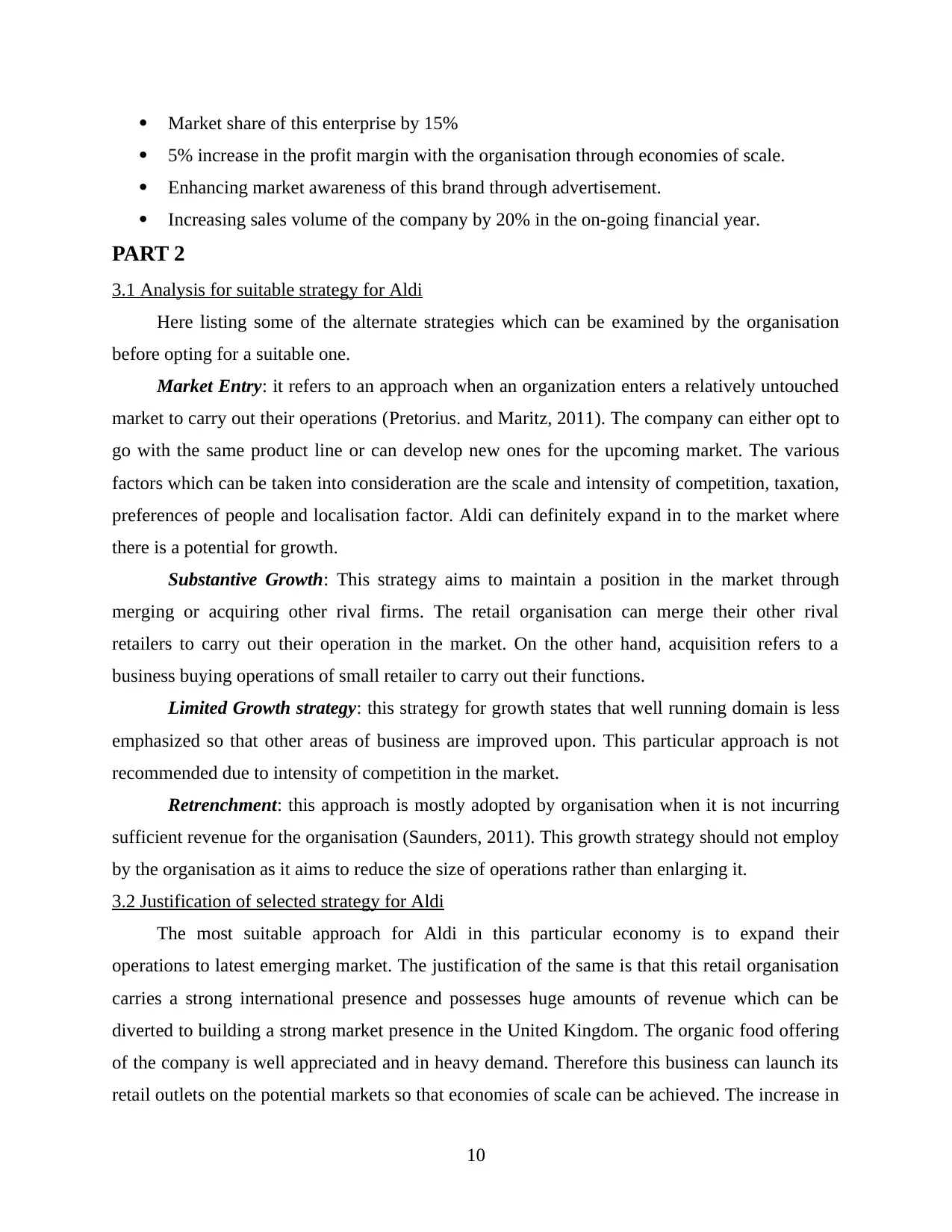
Market share of this enterprise by 15%
5% increase in the profit margin with the organisation through economies of scale.
Enhancing market awareness of this brand through advertisement.
Increasing sales volume of the company by 20% in the on-going financial year.
PART 2
3.1 Analysis for suitable strategy for Aldi
Here listing some of the alternate strategies which can be examined by the organisation
before opting for a suitable one.
Market Entry: it refers to an approach when an organization enters a relatively untouched
market to carry out their operations (Pretorius. and Maritz, 2011). The company can either opt to
go with the same product line or can develop new ones for the upcoming market. The various
factors which can be taken into consideration are the scale and intensity of competition, taxation,
preferences of people and localisation factor. Aldi can definitely expand in to the market where
there is a potential for growth.
Substantive Growth: This strategy aims to maintain a position in the market through
merging or acquiring other rival firms. The retail organisation can merge their other rival
retailers to carry out their operation in the market. On the other hand, acquisition refers to a
business buying operations of small retailer to carry out their functions.
Limited Growth strategy: this strategy for growth states that well running domain is less
emphasized so that other areas of business are improved upon. This particular approach is not
recommended due to intensity of competition in the market.
Retrenchment: this approach is mostly adopted by organisation when it is not incurring
sufficient revenue for the organisation (Saunders, 2011). This growth strategy should not employ
by the organisation as it aims to reduce the size of operations rather than enlarging it.
3.2 Justification of selected strategy for Aldi
The most suitable approach for Aldi in this particular economy is to expand their
operations to latest emerging market. The justification of the same is that this retail organisation
carries a strong international presence and possesses huge amounts of revenue which can be
diverted to building a strong market presence in the United Kingdom. The organic food offering
of the company is well appreciated and in heavy demand. Therefore this business can launch its
retail outlets on the potential markets so that economies of scale can be achieved. The increase in
10
5% increase in the profit margin with the organisation through economies of scale.
Enhancing market awareness of this brand through advertisement.
Increasing sales volume of the company by 20% in the on-going financial year.
PART 2
3.1 Analysis for suitable strategy for Aldi
Here listing some of the alternate strategies which can be examined by the organisation
before opting for a suitable one.
Market Entry: it refers to an approach when an organization enters a relatively untouched
market to carry out their operations (Pretorius. and Maritz, 2011). The company can either opt to
go with the same product line or can develop new ones for the upcoming market. The various
factors which can be taken into consideration are the scale and intensity of competition, taxation,
preferences of people and localisation factor. Aldi can definitely expand in to the market where
there is a potential for growth.
Substantive Growth: This strategy aims to maintain a position in the market through
merging or acquiring other rival firms. The retail organisation can merge their other rival
retailers to carry out their operation in the market. On the other hand, acquisition refers to a
business buying operations of small retailer to carry out their functions.
Limited Growth strategy: this strategy for growth states that well running domain is less
emphasized so that other areas of business are improved upon. This particular approach is not
recommended due to intensity of competition in the market.
Retrenchment: this approach is mostly adopted by organisation when it is not incurring
sufficient revenue for the organisation (Saunders, 2011). This growth strategy should not employ
by the organisation as it aims to reduce the size of operations rather than enlarging it.
3.2 Justification of selected strategy for Aldi
The most suitable approach for Aldi in this particular economy is to expand their
operations to latest emerging market. The justification of the same is that this retail organisation
carries a strong international presence and possesses huge amounts of revenue which can be
diverted to building a strong market presence in the United Kingdom. The organic food offering
of the company is well appreciated and in heavy demand. Therefore this business can launch its
retail outlets on the potential markets so that economies of scale can be achieved. The increase in
10
⊘ This is a preview!⊘
Do you want full access?
Subscribe today to unlock all pages.

Trusted by 1+ million students worldwide
1 out of 17
Related Documents
Your All-in-One AI-Powered Toolkit for Academic Success.
+13062052269
info@desklib.com
Available 24*7 on WhatsApp / Email
![[object Object]](/_next/static/media/star-bottom.7253800d.svg)
Unlock your academic potential
Copyright © 2020–2025 A2Z Services. All Rights Reserved. Developed and managed by ZUCOL.





